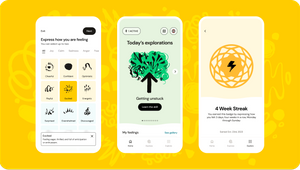
Code and Theory Introduces the First AI-Driven Anticipatory Graphic Design System for Publishers

Polling data is often difficult to understand in isolation. Digging deeper into the numbers tells a more complete story and provides the necessary context to understand the significant trends.
Enter ContextLens. It is the first anticipatory design system that dynamically generates informational graphics based on readers' needs.
Unlike generic AI tools that only focus on text input and output responses, ContextLens leverages generative AI to understand what information you are looking at on a web page. It then anticipates other content you may be interested in and creates a dynamic visual representation without making you leave the page.
This generative AI tool functions by reading the site's metadata structures to understand the "context" the user is reading and provides a "lens" to go deeper into content via AI prompts (either pre-populated or freeform).
The independent, nonpartisan media company RealClearPolitics (RCP) has selected its RealClearPolling website to be the first to employ this powerful new tool. RealClearPolling offers an aggregated, unbiased look at the dynamics of the presidential, Senate, House, and statewide races during this unprecedented 2024 election cycle. RealClearPolling is an extension of the RCP family, dedicated to delivering the most comprehensive, engaging look at U.S. election polls and public opinion surveys.
Here's how it works on RealClearPolling: The ContextLens is a purple bar in the bottom corner of a web page. Based on what you are looking at on the page, it anticipates what related content you may be interested in and auto-prompts suggestions. The user can engage with it right there on the page. The results expand by dynamically creating a graphic to give you more context.
For example, if a user looks at the "Electoral College: Top Battlegrounds" chart on RCP's home page, the ContextLens will suggest "Explore Electoral College." When a user clicks on it, three related options pop up: "Recent changes in support," "Who leads in key states," and "Electoral College forecast."
A graphic representation of the current data is generated once a user clicks on one of the topics. Users can also "Ask a question" to find other information.
Key features include:
- Contextual Understanding: The AI interprets the data users view and predicts where additional context is needed.
- Generative Visuals: Instead of overwhelming users with paragraphs of text, the system designs dynamic visuals to illustrate the point, offering more precise insights.
- Seamless Integration: Users don't need to leave the page they are looking at. The system provides expanded context right there, reducing disruption.
The new tool has many advantages: It gives users an unparalleled ability to explore and understand complex information without being overwhelmed. It allows sites with massive amounts of data to streamline it and represent it clearly. It also provides publishers with a new location to sell advertising inventory.
The ContextLens is currently in beta and available to other publishers.
RCP co-founder and executive editor Tom Bevan said, "For nearly a quarter of a century, RealClearPolitics has served as an innovator and an unbiased source of accurate information. ContextLens allows our users to pull from our years of data to form a complete picture of their topics of interest. Technology is breathing new life into the powerful data and reporting we are dedicated to providing. This marks a bold step in how people interact with complex information on the web."
Dan Gardner, co-founder of Code and Theory, said, "Polling is a perfect application for our first use of this technology. It is often confusing and hard to interpret. ContextLens simplifies this by dynamically designing visual elements based on the users' needs and the context in which they view them. It's the first anticipatory design system that intuitively creates elements on demand, giving more insight and clarity. Typical AI use cases have been limited to just text responses. We know people are also visual. This is the next step forward in how AI can be used in publishing to enhance reader experience, instead of solely focusing on AI as only an efficiency tool. ContextLens offers a glimpse into the future of AI and design, where context, anticipation and visual interpretation come together to create a fluid user experience."
Code and Theory has had a historic year when it comes to shaping how political information is conveyed. In addition to the launch of the ContextLens, it created Steve Kornacki's "Big Board." Kornacki uses the Big Board daily to visualise and explain complex polling data live on the air for millions. Code and Theory also relaunched the Minnesota Star Tribune as the heart and voice of the North, a week before Vice Presidential nominee Tim Walz was announced. The new site performed at the highest level during the biggest traffic day in the history of the site.
Code and Theory has launched nearly 200 newsrooms throughout its 23-year history. The new TechCrunch, which debuted this month, and Ringier's Blick, launched last month, are just the latest examples.















